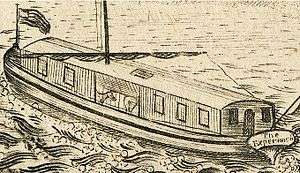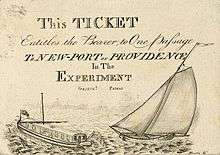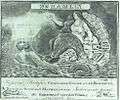William Hamlin
William Hamlin (15 October 1772 – 22 November 1869), an entrepreneur, was an early American engraver and the first engraver for the state of Rhode Island.[1][2]
William Hamlin | |
|---|---|
 ca. 1869 | |
| Born | 15 October 1772 |
| Died | 22 November 1869 |
| Resting place | Providence, Rhode Island |
| Nationality | American |
| Education | elementary |
| Occupation | businessman |
| Known for | engraver |
| Spouse(s) | Elizabeth Bowen (m.4/2/1810) daughter of Isaac Bowen |
| Children | Sarah Bowen (b. 1812) Richard Ely (b. 1814) William Erza (b. 1816) Samuel (b. 1818) John Hosmer (b. 1820) Isaac Bowen (b. 1824) |
| Parent(s) | Capt. Samuel & Thankful Ely married in 1771 |
| Relatives | gf Charles Hamlin ggf William Hamlin gggf Giles Hamlin. |
Biography
Hamlin, the son of a pewterer and brazier, was born, raised and died in Providence, Rhode Island,[3] and initially followed in his father's footsteps.[4] He was a person of respectable scientific skills, even though self-taught on his technical abilities.[5] Hamlin had no formal schooling in the engraving trade[1] and made his own tools for the work in mezzotint, aquatint and stipple.[6] He did, however, have some training as an engraver under the supervision of Samuel Canfield, a goldsmith and silversmith in Middletown, Connecticut (the town where his father was born in 1746).[1][7] Upon completion of his apprenticeship, he set up business in Middletown in 1791, and returned to Providence in 1795 "where his principle trade was engraving".[8]
Hamlin was born in the year of the Gaspée Affair, a significant event that lead up to American Revolution. He died four years after the American Civil War in 1869. He served as a second lieutenant in the First Rhode Island militia in 1778. In 1795 when he started engraving he set up shop on North Main Street directly next door to St. John's church in Providence.[9] He then made bank note plates.[1] Hamlin published the first view of Providence, Rhode Island, in one of his engravings.[2]
Hamlin was a manufacturer and repairer of optical instruments, telescopes, sextants, and quadrants as a business.[3] He was interested in astronomy and is said to have built the first telescope in the United States.[1] One of his many telescopes he made was also available to others to study the universe.[4]
Hamlin's parents, Capt. Samuel & Thankful Ely, married in 1771. Their other children (and Hamlin's siblings) were Samuel Ely (b.1774), Ann (b.1776), Richard Ely (b. 1779), Mehitable (b.1781), Mary (b.1783), and John Hosmer (b.1787).[9]
Career
Hamlin's first money making business was of selling all kinds of flutes, violins, flageolets, octave flutes, fifes and sheet music with his son (John) was first located directly across the street from the First Baptist Meetinghouse in Providence at 11 Cheapside in 1806–1809.[9] Later he moved his business closer to the harbor eight doors south where he sold and repaired optical, nautical and mathematical instruments for the navigational industry. In 1824, Hamlin's business was listed as: "Hamlin William, engraver and mathematical instrument maker, 135 South Main, 170 Benefit".[10] He was at 120 South Main in 1832, at 88 South Main in 1836, at 86 South Main in 1838, and at 69 South Water from 1841 to 1844.[9] Thereafter, he relocated to 131 South Water Street, and the business was called "At the Sign of the Quadrant" advertising compasses, quadrants, sextants, spyglasses, telescopes, and microscopes. The business was there from 1847 until Hamlin's death in 1869. It was at this business that he became inspired to become an engraver. His first attempts at engraving were done on copper.[5] Hamlin described himself strictly as a mathematical instrument maker after 1860, dropping the 'engraver' designation.[11]
Works
Hamlin did a variety of engravings (technically etchings), most of which were done on order such as membership certificates, bank notes, bookplates, watch papers, portraits and Providence buildings. Portraits of George Washington is his most enduring legacy.[12] He did four engravings of Washington for the 1800 publication "Memory of Washington" by Oliver Farnsworth.[13] They became the object of public exhibition.[14]
He was going to start engraving business cards as he had done for himself, but immediately became more ambitious and started engraving busts of George Washington. One was a copy of Philadelphia painter Edward Savage's bust portrait of Washington and another he did in his ninety-first year was a copy of Jean-Antoine Houdon's bust sculptor of Washington. Hamlin's print "The Burning of the Frigate Philadelphia in Tripoli Harbor, February 1804" is his most famous work.[5]
Many of Hamlin's engravings still exist and are in the form of bookplates, illustrated advertisements, marine scenes, Providence buildings and portraits. A famous specimen of his is the earliest view of Providence. He was a member of the Mechanics Association of Providence and engraved a "certificate of membership" for the members. One of his engravings shows the First Congregational Church on Benefit Street, with some flames and smoke, an indication of the fire that broke out that destroyed the church in 1814. Another notable engraving he did is that of the Experiment, a horse powered boat. He also engraved a ticket for The Experiment, entitling the bearer to a trip to New-Port or Providence.[1]
Hamlin engravings on notable people that still exist are of George Washington, Benjamin Franklin, William Eaton, Stephen Gano, Isaac Watts, William H. Harrison, Enos Hitchcock, and James Manning. He is also notable for making bank note engravings for several Rhode Island banks.[1]
Clubs
Gallery of engravings
 The Experiment,
The Experiment,
a horse powered boat
ca. 1808 Ticket for The Experiment ca. 1808
Ticket for The Experiment ca. 1808 Providence Marine Society membership certificate ca. 1798
Providence Marine Society membership certificate ca. 1798 First Congregational Church of Providence ca. 1814
First Congregational Church of Providence ca. 1814 George Washington
George Washington
engraving off Savage
ca. 1799
" Courtship / Matrimony " trick engraving
ca. 1798 At the Sign of the Quadrant Hamlin's business card showing his occupations
At the Sign of the Quadrant Hamlin's business card showing his occupations
ca. 1850 Hamlin's trade card
Hamlin's trade card
131 S. Water Street
ca. 1847 Engagement between the Peacock and the Epervier 29 April 1814
Engagement between the Peacock and the Epervier 29 April 1814
Bibliography
References
- Lane, Gladys R. (Librarian of the Shepley Library, Providence, Rhode Island) (19 March 1925). Antiques Magazine: Rhode Island's Earliest Engraver. Antiques Magazine. VII. p. 133.
- Rhode Island Historical Society collections,. 15–18. Rhode Island Historical Society. 1922. p. 96.
- Andrews, p. 144
- Bedini, p. 408-411
- Malone, p. 198
- Dunlap, p. 305
- Bohan, Peter; Hammerslough, Philip; Eisenbarth, Erin (introduction) (2007) [1970]. Connecticut Silver, 1700–1840. Middletown, Connecticut: Wesleyan University Press. p. 228. ISBN 0-8195-6848-1. Retrieved 12 July 2016. ISBN 978-0-8194-7848-1.
- Bohan, Peter; Hammerslough, Philip; Eisenbarth, Erin (introduction) (4 December 2007). Early Connecticut Silver, 1700–1840. p. 237. ISBN 9780819568489. Retrieved 10 December 2011.
- Preuss, Anne MacDougall (August 1989). Rittenhouse, Journal of the American Scientific Instrument Enterprise, Vol. 3, No. 4. p. 135.
- Providence City Directory. 1824. p. 35. Retrieved 9 December 2011.
- The Providence Directory (1824 and later)
- Club, p. 37
- The bookman, p. 576
- See Grolier Club (1899). Exhibition of engraved portraits of Washington commemorative of the centenary of his death, on view at the Grolier club ... New York, Dec. 14th, 1899, to Jan. 6th, 1900. New York: The De Vinne press. Retrieved 9 December 2011.
Sources
- Andrews, Henry Franklin (1900). The Hamlin family: a genealogy of Capt. Giles Hamlin of Middletown, Connecticut, 1654–1900. H.F. Andrews. Retrieved 9 December 2011. at Google books
- Bedini, Silvo (2001). With compass and chain: early American surveyors and their instruments. Professional Surveyors Pub. Co. ISBN 0-9665120-0-6.
- Bohan, Peter; Hammerslough, Philip; Eisenbarth, Erin (introduction) (2007) [1970]. Connecticut Silver, 1700–1840. Middletown, Connecticut: Wesleyan University Press. p. 228. ISBN 0-8195-6848-1. Retrieved 12 July 2016.
- Dunlap, William (1918). A history of the rise and progress of the arts of design in the United States. 3. Boston: C.E. Goodspeed & Co. p. 305. Retrieved 9 December 2011.
- Grolier Club (1908). Catalogue of an exhibition of early American engraving upon copper: 1727–1850. The De Vinne Press. Retrieved 9 December 2011.
- Malone, Dumas (1932). Dictionary of American Biography ("William Hamlin"). VIII. New York: Charles Scribner's Sons.
- The bookman. American periodical series, 1850–1900). 10. Dodd, Mead and Co. 1899. Retrieved 9 December 2011.
Further reading
- Brown University has documents that pertain to William Hamlin, including a self-portrait. Brown University, World Catalog.
- Emlen, Robert P. (May 1985). "An Embossed Leather Cockade by Providence Engraver William Hamlin" (PDF). Rhode Island History. p. 44.
- Farnsworth, Oliver (1775–1859); Hamlin, William (1772–1869), engraver; Savage, Edward (1761–1817). "Memory of Washington (electronic resource): comprising a sketch of his life and character; and the national testimonials of respect. Also, a collection of eulogies and orations. With a copious appendix". full text on line at National Library of Australia.
- Fincham, Henry Walter (1897). Artists and engravers of British and American book plates: with a list of the plates they have executed. Paternoster House Charing Cross Road: Kegan Paul Trench TrŰbner & Co. Ltd. p. 39. Retrieved 9 December 2011.
- Grolier Club (1899). Exhibition of engraved portraits of Washington commemorative of the centenary of his death, on view at the Grolier club ... New York, Dec. 14th, 1899, to Jan. 6th, 1900. New York: The De Vinne press. Retrieved 9 December 2011.
- Museum of Fine Arts, Boston (1904). A Descriptive Catalogue of an Exhibition of Early Engraving in America December 12, 1904 – February 5, 1905. Cambridge: The University Press. p. 44.
- Providence City Directory. 1824. p. 35. Retrieved 9 December 2011.
- "William Hamlin: An Elusive Providence Instrument Maker". Journal of the American Scientific Instruments Enterprise. Rittenhouse. 3 (12): 136–137. August 1989.
- VanWye, Eugene (April 1961). "William Hamlin: Providence Engraver". Rhode Island History. 20 (2): 33–44.